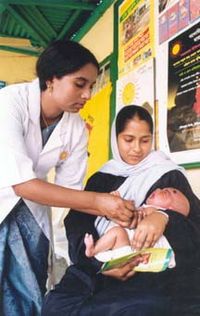
Photo from wikipedia
Comprehensive strategies to address childhood obesity are needed. Despite recent stabilization of prevalence among 2to 11-year-old children, nearly one-third of US children and adolescents are overweight (body mass index [BMI]… Click to show full abstract
Comprehensive strategies to address childhood obesity are needed. Despite recent stabilization of prevalence among 2to 11-year-old children, nearly one-third of US children and adolescents are overweight (body mass index [BMI] 85th-95th percentile for age and sex on US Centers for Disease Control and Prevention growth charts) or have obesity (BMI ≥95th percentile).1 Substantial disparities exist by race/ ethnicity: more than 20% of Hispanic boys and girls and nonHispanic black girls have obesity compared with 14% to 15% of non-Hispanic white girls and boys. The prevalence of extreme obesity (BMI ≥120% of the 95th percentile) is rising and is nearly 6% among all children and adolescents and 9% among black girls. The benefit of treatment for obesity is clear. Updating its 2010 statement, the US Preventive Services Task Force (USPSTF) has provided another meticulous evidence-based recommendation on obesity screening and treatment for children and adolescents.2 Unchanged from the 2010 recommendation statement, the top-line conclusion supports screening and treatment for obesity for children older than 6 years of age (grade B). The specific treatments recommended are “comprehensive, intensive behavioral interventions”2 that are multicomponent and incorporate activities such as counseling children and their families regarding nutrition, physical activity, and techniques to help change behavior through self-monitoring, goal setting, and problem solving. Based on growth in the evidence base, including the quality of studies, the recommendations are more far-reaching and specific than in 2010. For the 2017 recommendation, the USPSTF incorporated results from 42 trials with multicomponent behavioral interventions involving nearly 7000 children.3 These trials included 8 rated as “good quality.”3 However, only about one-quarter of these studies included adolescents, limiting inferences about this group. Screening is still recommended, using ageand sex-specific BMI, as are obesity treatment programs that provide at least 26 contact hours; contact hours were calculated based on the number and length of intervention sessions. Evidence points to a dose response of treatment, with the greatest success achieved by programs with at least 52 contact hours (7 trials tested interventions of this length). These longer-duration programs have clear evidence of improvements in weight status and some related cardiometabolic risk factors after 6 or 12 months of follow-up. The findings on cardiometabolic risk factors are notable considering that sustained improvements early in life will likely have longterm benefits in preventing diabetes and metabolic diseases in adulthood.4 The USPSTF found no overall evidence of harm resulting from treatment (10 studies assessed harm). They found no studies that directly examined harms from screening. Several states have implemented BMI screening in schools, and parental responses to those efforts have been mixed. Some parents reported skepticism and concern, especially regarding possible stigma or negative health consequences of screening such as the inducement of eating disorders.5 Other states have had more positive experiences.6 More research is needed in clinical and school environments to determine whether harm actually results from screening efforts.
Journal Title: JAMA Internal Medicine
Year Published: 2017
Link to full text (if available)
Share on Social Media: Sign Up to like & get
recommendations!